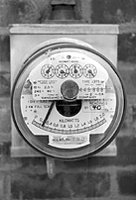

When the average student thinks about energy consumption, she might be thinking more about an extra cookie at lunch than the computer she left on in her room. But that might change if Director of Environmental Health and Safety Cheryl Wolfe gets her way.
"If everyone turned off their computer monitors for eight hours a day, it would add up to a yearly savings of over $60,000," she said.

Ten years ago, Environmental Studies Professor David Orr encouraged the College to undergo a massive evaluation of energy use in an attempt to reduce emissions by the coal plant and reduce use overall. "We really missed the boat ten years ago, and we've been piece-mealing it ever since," Wolfe said.
This year, College President Nancy Dye initiated a plan to reduce energy use by the College, and her first area of concern was the Physical Plant. In a much contested move, the College shut down its central heating system over the winter break between Dec. 23 and Jan. 2. Assistant Director of Facilities Operations Kevin Jacobs said the plant managed to reduce energy consumption by 35 Continued from page 1
But when it comes to actual power use reduction, how many students think about it on a daily basis?
Some students living on campus do not seem overly concerned, but they weren't completely oblivious to it. "I never have my lights on," first-year Molly Ryan said. She admitted, however, that this was her preference rather than an ecologically based decision.
Sophomore Jane Garelik said, "I think to turn my lights off before I leave." However, Garelik did admit that she leaves her computer on.
Senior Caroline Cohen lives off campus. Her utilities are included in her rent, but she said she thinks about power use more than when she was living in the dorms. "I try to keep my showering to a minimum time, and the other people in our house are good at conserving utilities," Cohen said. "I didn't think about it too much in the dorms."
Junior Christina Choi, who also lives off-campus, agreed, saying she definitely thinks about power use more than when she lived in the dorms. Even though utilities are not included with her rent, however, she was reserved about calling her attention to energy "extensive." "Actually, we're not very concerned about it," she said.
Members of the source reduction team believe that if students are aware of how the College produces and uses power, they will be more conscious of how they use electricity from day to day.
Many students are unaware of the activities that go on in the Physical Plant. Behind the factoryesque facade that flanks the west end of campus, a complex system of heating and churning and brewing combines to send high pressure steam to the edges of campus, heating the buildings and the water.
The plant operates three boilers: two coal fired and one gas fired. The boilers work in a normal fashion, heating water into steam, then harnessing that steam to heat buildings. However, the steam is also converted into power through turbines that are also on site. Only 130,000 KWH is generated in the "co-gen," so the College easily uses all the power it produces. This is merely supplemental to the power Oberlin Municipal Light and Power provides the school.
According to Steve Dupee, key accounts and utilities service manager at Oberlin Light and Power, the school buys on average 1.7 million KWH per month. This totals approximately 15 to 20 percent of the power use of the city.
Vick Oefterin, technical services supervisor at Oberlin Light and Power, said this proportion of power consumption has always been in place.
"Oberlin Light and Power didn't exist until 1934. Before that it was an investor-owned company. I'm sure Oberlin College was instrumental in establishing Oberlin Light and Power. We've been very competitive over the years," Oefterin said.
Indeed, the company sees a marked increase in power use in September compared to the summer months. Peak usage is usually seen in the coldest and hottest months; however, Dupee said the College's energy use is fairly steady except for the summer months.
Data from 1996 show that the College used 21.3 million KWH in one year, and in one month, the College can spend upwards of $1 million per month on electricity.
Meter Reader: Over 40 campus meters measure energy use. (photos by Zach Williamson)
Copyright © 1998, The Oberlin Review.
Volume 127, Number 14, February 19, 1998
Contact us with your comments and suggestions.